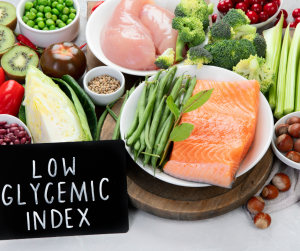The glycemic index (GI) is a ranking system that classifies carbohydrate-containing foods by how they impact your blood sugar levels. Understanding the GI can help you make informed food choices to better manage your blood sugar and overall health.
What is the Glycemic Index?
The glycemic index ranks foods that contain carbohydrates on a scale of 0 to 100 based on how they affect your blood sugar. Foods are ranked in comparison to the reference food, pure glucose, which has a GI value of 100.
- Low GI foods have a GI of 55 or less. They break down slowly and cause a gradual rise in blood sugar. Examples are beans, lentils, nuts, fruits like apples and oranges, and non-starchy vegetables.
- Medium GI foods have a GI between 56-69. They cause a moderate rise in blood sugar. Examples are whole wheat bread, sweet potatoes, brown rice.
- High GI foods have a GI of 70 or more. They break down quickly and lead to a fast, dramatic spike in blood sugar. Examples are white bread, potatoes, white rice, and processed sweets.
Why Follow a Low GI Diet?
Choosing more low-GI foods can provide health benefits:
- Improved blood sugar control. Low GI foods help keep blood sugar steady and prevent energy crashes and spikes. This is especially helpful for diabetes management.
- Weight loss. Low GI foods are more filling and less likely to cause overeating and weight gain.
- Reduced heart disease risk. Diets based on low GI foods have been linked to lower “bad” LDL cholesterol and reduced heart disease risk.
- Improved insulin sensitivity. A low GI diet can help your cells become more sensitive to insulin and stabilize blood sugar.
 Tips for Following a Low GI Diet
Tips for Following a Low GI Diet
Here are some practical tips for basing your diet on low-GI foods:
- Choose whole grains like oats, quinoa, and whole wheat over processed grains like white bread.
- Load up on non-starchy vegetables like leafy greens, broccoli, and peppers.
- Pick fruits like apples, oranges, grapes, and berries over bananas, dates, and raisins.
- Use beans, lentils, nuts, seeds, and minimally processed soy foods like tofu and edamame as protein sources.
- Select lean meats like chicken, fish, and shellfish over high-fat cuts of meat.
- Limit added sugars, sweets, sugary drinks, and processed “white” carbs like white bread.
- Combine carbs with protein, fat or fiber to help slow digestion. For example, eat oatmeal with nuts and berries.
Making the glycemic index work for you is about choosing wholesome, fiber-rich carbs that provide longer-lasting energy. A low GI diet can be a healthy, sustainable approach to better blood sugar control and overall well-being.
Need help identifying low-GI foods? Let’s strategize.
Want to hear about my Crowd Out the Bad Method to Conquer Cravings, Lose Weight, and Avoid Diabetes? Take the First Step with a FREE Consultation and Learn from My 135-Pound Victory Over Pre-Diabetes!

 Tips for Following a Low GI Diet
Tips for Following a Low GI Diet





Great list to follow! I basically eat a low GI diet, I love green vegetables, fish, beans and nuts and never drink sugary drinks!
Sugary drinks are like liquid death so it’s a really good thing to avoid.